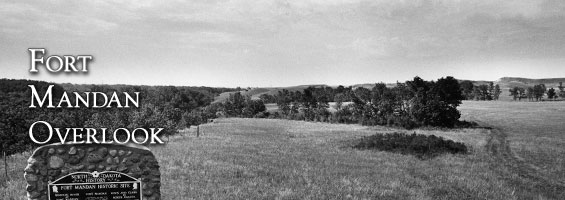We’ve launched a new web portal! Visit findhistory.nd.gov to search our collections.
Due to a road closure, the Killdeer Mountain Battlefield State Historic Site is temporarily closed.

Fort Mandan Overlook is so named because the site overlooks the area where Lewis and Clark established their headquarters, called Fort Mandan, in the winter of 1804-1805. Fort Mandan was a triangular fort which provided shelter, protection, and a place of cultural interchange between the explorers and the area’s Indian inhabitants, for whom the fort was named. The original site of Fort Mandan was beside the river and has been inundated.
In 1991-1992 State Historical Society archeologists excavated part of the site, which lies fourteen miles west of Washburn, McLean County, overlooking the Missouri River. Based on these studies, we now know that people lived at this location during two different times: once during the late-1700s to mid-1800s and earlier, around A.D. 1300 to 1400. An irregular ditch constructed sometime during the late-eighteenth century to mid-nineteenth century is the most visible feature at this archeological site. At present no historic documents have been found that identify the date of construction of the ditch, the builders, or the events that transpired there. Historic-period artifacts found in the sod and just below it include glass trade beads, a gunflint, lead shot, and glass fragments.
Although the historic events at the site remain a puzzle, the prehistoric use is better understood. A significant Plains Village campsite was discovered by the archeologists. While no houses were detected during excavation or are visible on the ground surface, contemporary Plains Villagers in the area lived in rectangular houses (see Huff Indian Village).
Recovered artifacts include pottery, arrowheads, scrapers, flakes, grinding tools, bison shoulder-blade hoe fragment, butchered animal bones, and corn kernels and cobs. A pit filled with ash and a hearth were also uncovered. Charcoal from the hearth was radiocarbon dated to A.D. 1300 to 1400. Based on the archeological excavations, inhabitants occupying the site more than six centuries ago were involved in such activities as food preparation, hide processing, and stone-tool production and repair.
There are two markers at the site, one identifying it as a state historic site and the other placed there by the Order of the Masons.
SHSND Address:
612 East Boulevard Ave.
Bismarck, North Dakota 58505
Get Directions
SHSND Hours:
Museum Store: 8am - 5pm M-F; Sat. & Sun. 10am - 5pm.
State Archives: 8am - 4:30pm., M-F, except state holidays, and 2nd Sat. of each month, 10am - 4:30 pm.
State Historical Society offices: 8am - 5pm M-F, except state holidays.
Contact SHSND:
phone: 701.328.2666
email: history@nd.gov